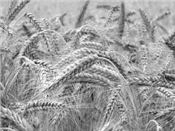|
Wheat Co-products Vary In Protein Digestibility When Fed To Pigs

URBANA, ILL.
Research from the University of Illinois is helping to determine the quality of protein in wheat middlings and red dog, two coproducts of the wheat milling process that can be included in diets fed to pigs and other livestock.
Red dog consists mainly of the aleurone layer that lies between the bran and the endosperm, along with small particles of bran, germ, and flour. Wheat middlings are granular particles of the wheat endosperm, bran, and germ. They contain about three times as much dietary fiber as red dog.
“We have information about the digestibility of crude protein in some wheat coproducts produced in Canada and China, but only very limited information about the nutritional value of wheat middlings and red dog produced in the United States,” says Hans H. Stein, professor in the Department of Animal Sciences at U of I.
“In addition, because wheat coproducts vary in terms of the conditions under which they are produced, their nutritional value may vary as well,” he says.
Stein and Ph. D. candidate Gloria Casas procured wheat middlings from ten suppliers in Colorado, Iowa, Illinois, Kansas, Michigan, Minnesota, Ohio, and Pennsylvania, along with red dog from a supplier in Iowa, and fed them to growing pigs.
Despite the variety in the sources of wheat middlings, the concentration and standardized ileal digestibility (SID) of crude protein were generally consistent. However, there was variation in the digestibility of most amino acids among sources of wheat middlings.
Red dog contained slightly less crude protein than wheat middlings: the mean protein concentration of the wheat middlings samples was 17.67 percent, compared with 17 percent in red dog.
However, the SID of crude protein and all but three amino acids – arginine, histidine, and serine – was greater in red dog than in wheat middlings.
According to Stein, “The SID of amino acids is probably greater in red dog because it contains less fiber compared with wheat middlings. It’s also possible that excessive heat was used in the processing of the wheat middlings, causing heat damage.”
The SID of lysine, the amino acid most susceptible to heat damage, was 72.3 percent in red dog but averaged only 46.2 percent in wheat middlings.
Stein says the results of this study provide guidance to producers who hope to incorporate wheat co-products into diets fed to pigs.
“The amino acids in red dog are well digested, so there should be no problem with incorporating them into swine diets,” he says. “However, we would advise anyone feeding wheat middlings to add crystalline amino acids or other protein sources so that the diet will have sufficient digestible amino acids.” ∆
|
|